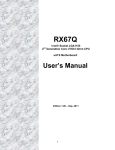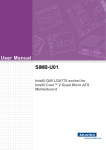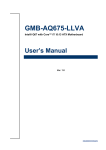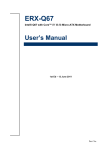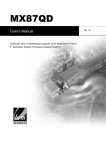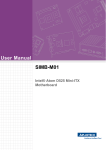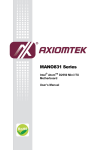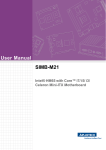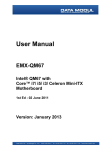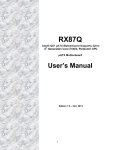Download User`s Manual - BCM Advanced Research
Transcript
MX61H User’s Manual Intel® H61 Mini ITX Motherboard supports 22nm/32nm Intel® Core™ i7/i5/i3 Desktop Processors (Ivy Bridge / Sandy Bridge Platform) Ver 1.0 MX61H User’s Manual Table of Content 1.1 Product highlights ...................................................................................................14 1.2 Before you Proceed .................................................................................................16 1.3 Motherboard Overview ............................................................................................17 1.3.1 Placement Direction................................................................................................17 1.3.2 Screw Holes.................................................................................................................17 1.3.3 Motherboard Layout.....................................................................................................18 1.3.4 Layout Content List ......................................................................................................18 1.3.5 Internal Connector .......................................................................................................20 1.4 Central Processing Unit (CPU)................................................................................21 1.4.1 Installing the CPU ........................................................................................................22 1.4.2 Installing the CPU Heatsink and Fan ...........................................................................24 1.5 System Memory........................................................................................................27 1.5.1 Overview ......................................................................................................................27 1.5.2 Memory Configurations................................................................................................28 1.5.3 Installing a DDR3 DIMM ..............................................................................................28 1.5.4 Removing a DDR3 DIMM.............................................................................................29 1.6 Expansion Card ........................................................................................................30 1.6.1 Installing an Expansion Card .......................................................................................30 1.6.2 Configuring an Expansion Card ...................................................................................31 1.6.2.1 PCI Express x16 slot.................................................................................................31 1.6.2.2 MiniPCI express slot .................................................................................................32 1.7 Jumpers ....................................................................................................................32 1.7.1 Clear CMOS (JCMOS1)...............................................................................................32 1.7.2 AT/ATX Power Mode Select (PSON1).........................................................................33 1.7.3 Chassis Intrusion Connector (JCASE1) .......................................................................34 1.7.4 COM1, COM2, COM3, COM4 RI/+5V/+12V Select (JCOMPWR1, JCOMPRW2, JCOMPWR3, JCOMPWR4).........................................................................................34 1.8 Connectors ...............................................................................................................35 1.8.1 Rear panel connectors.................................................................................................35 1.8.2 CPU and System fan connectors (CPU_FAN 1,SYS_ FAN1)......................................36 1.8.3 System Panel (F_PANEL1)..........................................................................................37 1.8.4 ATX power connectors (EATXPWR1, ATX12V1) ........................................................38 1.8.5 Serial Port connectors (COM3, COM4)........................................................................39 1.8.6 Digital IO Connector (JDIO1) .......................................................................................39 1.8.7 PARALLEL PORT Connector (LPT1) ..........................................................................40 1.8.8 RS232/422/485 Selection (JSETCOM1)......................................................................40 1.8.9 Low-voltage differential signalling Connector(JLVDS1) ...............................................41 1.8.10 LCD Inverter Connector (JBKL1) ...............................................................................41 2 MX61H User’s Manual MX61H User’s Manual 1.8.11 Audio Mic.-In & Line-Out Connector (F_AUDIO1)......................................................42 1.8.12 Amplifier Connector (JAMP_1) ..................................................................................42 1.8.13 Serial ATA Connector (SATA1, SATA2,SATA3,SATA4)............................................43 1.8.14 USB connectors (USB56, USB78) .............................................................................43 2.1 BIOS Setup Program................................................................................................46 2.1.1 Legend Box..................................................................................................................47 2.1.2 List Box ........................................................................................................................47 2.1.3 Sub-menu ....................................................................................................................47 2.2 BIOS Menu Screen ...................................................................................................48 2.3 Main Setup ................................................................................................................49 2.4 Advanced BIOS Setup…………………………………………………………………….50 2.4.1 PCI Subsystem Setting ................................................................................................51 2.4.2 ACPI Settings ..............................................................................................................52 2.4.3 Trusted computing .......................................................................................................53 2.4.4 CPU configuration........................................................................................................54 2.4.5 SATA Configuration .....................................................................................................55 2.4.6 USB Configuration .......................................................................................................56 2.4.7 Super IO Configuration ................................................................................................57 2.4.9 Hardware Monitor ........................................................................................................64 2.4.10 Option ROM Policy ....................................................................................................67 2.4.11 CPU PPM Configuration ............................................................................................68 2.5 Chipset......................................................................................................................69 2.5.1 PCH-IO Configuration ..................................................................................................70 2.5.2 System Agent (SA) Configuration ................................................................................73 2.6 2.7 2.8 Boot...........................................................................................................................78 Security.....................................................................................................................80 Save & Exit ...............................................................................................................81 MX61H User’s Manual 3 MX61H User’s Manual Safety Information Electrical safety To prevent electrical shock hazard, disconnect the power cable from the electrical outlet before relocating the system. When adding or removing devices to or from the system, ensure that the power cables for the devices are unplugged before the signal cables are connected. If possible, disconnect all power cables from the existing system before you add a device. Before connecting or removing signal cables from the motherboard, ensure that all power cables are unplugged. Seek professional assistance before using an adapter or extension cord. These devices could interrupt the grounding circuit. Make sure that your power supply is set to the correct voltage in your area. If you are not sure about the voltage of the electrical outlet you are using, contact your local power company. If the power supply is broken, do not try to fix it by yourself. Contact a qualified service technician or your retailer. Operation safety Before installing the motherboard and adding devices on it, carefully read all the manuals that came with the package. Before using the product, make sure all cables are correctly connected and the power cables are not damaged. If you detect any damage, contact your dealer immediately. To avoid short circuits, keep paper clips, screws, and staples away from connectors, slots, sockets and circuitry. Avoid dust, humidity, and temperature extremes. Do not place the product in any area where it may become wet. Place the product on a stable surface. If you encounter technical problems with the product, contact a qualified service technician or your retailer. The symbol of the crossed out wheeled bin indicates that the product (electrical and electronic equipment) should not be placed in municipal waste. Check local regulations for disposal of electronic products. 4 MX61H User’s Manual MX61H User’s Manual Safety Declaration This device complies with the requirements in Part 15 of the FCC rules. Operation is subject to the following two conditions: This device may not cause harmful interference. This device must accept any interference received, including interference that may cause undesired operation. About this guide This user guide contains the information you need when installing and configuring the motherboard. How this guide is organized This manual contains the following parts: Chapter 1: Product introduction This chapter describes the features of the motherboard and the new technology it supports. This chapter also lists the hardware setup procedures that you have to perform when installing system components. It includes description of the jumpers and connectors on the motherboard. Chapter 2: BIOS setup This chapter tells how to change system settings through the BIOS Setup menus. Detailed descriptions of the BIOS parameters are also provided. Where to find more information Refer to the following sources for additional information and for product and software updates. 1. Technical Support If a problem arises with your system and no solution can be obtained from the user’s manual, please contact your place of purchase or local distributor. 2. Optional documentation Your product package may include optional documentation, such as warranty flyers, that may have been added by your dealer. These documents are not part of the standard package. MX61H User’s Manual 5 MX61H User’s Manual Conventions used in this guide To make sure that you perform certain tasks properly, take note of the following symbols used throughout this manual. DANGER/WARNING: Information to prevent injury to yourself when trying to complete a task. CAUTION: Information to prevent damage to the components when trying to complete a task. IMPORTANT: Instructions that you MUST follow to complete a task. NOTE: Tips and additional information to help you complete a task. Typography Bold text Italics <Key> Indicates a menu or an item to select Used to emphasize a word or a phrase Keys enclosed in the less-than and greater-than sign means that you must press the enclosed key Example: <Enter> means that you must press the Enter or Return key <Key1>+<Key2>+<Key3> If you must press two or more keys simultaneously, the key names are linked with a plus sign (+) Example: <Ctrl>+<Alt>+<D> Means that you must type the command exactly as shown, Command then supply the required item or value enclosed in brackets Example: At the DOS prompt, type the command line: afudos /i[filename] afudos /iP5P800VM.ROM 6 MX61H User’s Manual MX61H User’s Manual Packing List Before you begin installing your single board, please make sure that the following materials have been shipped: 1 x MX61H Mini-ATX Main board 1 x DVD-ROM contains OS device drivers 2 x COM cables 2 x SATA cables 1 x I/O Shield 1 x Quick Installation Guide If any of the above items is damaged or missing, please contact your retailer. MX61H User’s Manual 7 MX61H User’s Manual Revision History Revision V 1.0 Revision History First release version 8 MX61H User’s Manual Date 2012/09/06 MX61H User’s Manual Specifications Summary CPU Chipset Memory Display Audio LAN Features Expansion Socket LGA1155 supports Core i7/i5/i3, Celeron, Pentium CPU Intel® H61 2 x 204 Pin SODIMM sockets supports DDR3 memories 1066/1333 MHz up to 16GB Intel® Intel® HD Grpahics 2000/3000/4000; DVMT Support up to 1.7GB Memory Realtek® ALC892, 5.1 with Multiple Streaming HD Audio Realtek 8111E Gigabit Ethernet controller Realtek 8111E Gigabit Ethernet controller 1 x PCI-E x16 1 x miniPCI-E x1 1 x VGA & 1 x DVI-D 4 x COM, (With power 5v/12v) I/O 8 x USB 2.0 (4F/4R) 4 x SATAII 1x LPT (pin header) 1x PS2 MS/KB Others 8 Bit GPIO (DIO)/Front audio / TPM 1.2 (optional) MX61H User’s Manual 9 MX61H User’s Manual Specifications System CPU Socket LGA1155 supports Core i7/i5/i3, Celeron, Pentium CPU BIOS AMI 32 Mb BIOS System Chipset Intel® H61 I/O Chipset Nuvoton NCT6776F Memory Watchdog Timer H/W Status Monitor 2 x 204 Pin SODIMM sockets supports DDR3 memories 1066/1333 MHz up to 16GB Reset: 1 sec.~255 min. and 1 sec. or 1 min./step Monitoring temperatures, voltages, and cooling fan status. Auto throttling control when CPU overheats Expansion Slots 1 x PCI-E x16 slot, 1 x miniPCI slot DIO 8 Bit GPIO S3 / S4 Yes TPM TPM1.2 (Infineon® TPM chip 9635 TT 1.2 on board, optional) Wake up on LAN or Ring Smart Fan Control LAN (PXE) Yes, CPU FAN(by SIO) Display Chipset Intel® HD Grpahics 2000/3000/4000 integrated Display Memory DVMT Support up to 1.7GB Memory Max. Resolution 2048 x 1536 bpp(@ 75Hz) Dual Display DVI + VGA VGA on board DVI on board, via level shifter Audio Audio Codec Realtek® ALC892, 5.1 +2 with two independent Streaming Audio Interface Line in, Line Out, Mic-in 10 MX61H User’s Manual MX61H User’s Manual Specifications Ethernet LAN1 Realtek 8111E GbLAN Controller LAN2 Realtek 8111E GbLAN Controller Back I/O Port 1 x PS2 KB/MS 1 x VGA 1 x DVI-D Back Panel 2 x COM port 2 x RJ45 port 4 x USB 2.0 1 x 3 Audio Jacks(Line-in/Line-Out/Mic in) Internal I/O Connector 4 x SATAII connectors 2 x USB connectors support additional 4 USB 2.0 ports 2 x COM header 1 x CPU Fan connector 1 x System Fan connector Internal I/O 1 x Chassis Intrusion header 1 x Front Audio header 1 x Front panel header 1 x LPC Printer port 1 x 8 Bit DIO header 1 x 24-pin ATX Power connector 1 x 4-pin ATX 12V Power connector Mechanical & Environmental Power Type AT/ATX Operating Temperature 0~60°C (32~140°F) Operating Humidity 0%~90% relative humidity, non-condensing Size (L x W) 9.6" x 9.6" (243.84 mm x 243.84 mm) Weight 1.35 lbs (0.64 Kg) * Specifications are subject to change without notice. MX61H User’s Manual 11 MX61H User’s Manual Block Diagram 12 MX61H User’s Manual MX61H User’s Manual This chapter describes the motherboard features and the new technologies it supports. 1 Product Introduction MX61H User’s Manual 13 MX61H User’s Manual Chapter 1 - Product Introduction 1.1 Product highlights 1.1.1 Product Overview Supports latest Intel LGA 1155 CPU-socket interface processor, the 2nd and 3rd Generation Intel® Core i3, i5, i7 desktop processors which are built on 32 nm and 22nm technologies to provide smart performance and responsiveness on executing tasks, It combines the CPU and GPU to offer fantastic HD media and graphics, especially on 3D gaming experience. Doubles the bandwidth of your system memory up to 25.6 GB/s and pumps up the system performance at lower power. DMI (Direct Media Interface) architecture connects between the processor and chipset at 5.0GT/s which twice the speed of previous version. The exceptionally increased interconnect bit rate from 2.5GT/s up to 5.0GT/s would effectively eliminates the bottle neck of the system performance and brings the most terrific computing experience from the present to the future. Doubles the transfer speed of SATA, running at speed up to 3.0Gb/s, and can connect with any other SATA 1.5Gb/s devices for backward compatibility. Integrated 5.1-channel HD Audio CODEC delivering advanced multi-channel audio and bringing you the experience of home theater-quality sound. Gigabit LAN is the networking standards for the future and is ideal for handing large amount of data such as video, audio, and voice. Delivers transfer speed ten times faster than conventional 10/ 100 Ethernet connections, supporting a high transfer rate up to Gigabit/s. Choose an environment-friendly, fully RoHS-compliant ECS product as the foundation for keeping harmful substances out of our ecosystem. 1.1.2 Platform Features and Benefits •Integrated Gfx (Intel® HD Graphics 4000/3000/2000) with enhanced operating modes to enable excellent graphics performance in power and cost sensitive embedded applications • DirectX® 10.1 & Open GL 3.0 let you enjoy awesome graphics performance, stunning 3D visual effect and dynamic interactivity • Memory support, integrated low voltage DDR3 memory controller • Operating system support: - Microsoft 14 MX61H User’s Manual MX61H User’s Manual -WindRiver -Redhat -Novell -Green Hills -QNX - LinuxWorks 1.1.3 Key Architecture Features • Supports Intel LGA 1155 CPU, the 2nd and 3rd Generation Intel® Core i3, i5, i7 desktop processors. -32nm / 22 nm monolithic die -Integrated Gfx (Intel® HD Graphics 4000/3000/2000) & memory controller -4&2 Cores, up to 6MB LLC -HW accelerated video CODECs - Compatible with high speed DDR3-1333 -PCIe* (CPU): Gen 2.0, 5GT/s, up to 20 lanes (4 ctls)** -TDP: 17W-45W (Low Power), 65W-95W (Scalable) • Intel® Turbo Boost Technology -More efficient power sharing between CPU and Graphics • Intel® Hyper-Threading Technology • Intel® Advanced Vector Extensions (Intel® AVX) • Intel® AES-New Instructions • Integrated Display Interfaces - Dual Independent Display Support - DVI-D - Analog VGA • Intel® HD Graphics 4000/3000/2000 - DirectX® 10.1 - Improved realism for DX 3D applications. Improved rendering. - OpenGL 3.0 - Improved realism for OGL 3D based application - UVD (Unified Video Decoder) 2.01 Hardware decode of most common HD codecs (MPEG-2, H.264/AVC MPEG-4 and VC-1) • Intel Quick Sync Video - Enables faster and higher quality video editing, recording and sharing • I/O - PCI Express® x 16 Gen 2 5GT/s - Mini PCI Express® Gen 2 5GT/s MX61H User’s Manual 15 MX61H User’s Manual - Four SATA ports (Gen 2.0) - Gigabit Ethernet Media Access Controller (GbE MAC) IPv4 and IPv6 Checksum Offload - High Definition Audio - USB: Gen 2.0, up to 8 ports - SMBus 2.0 - LPC Bus Supports SPI devices - Hardware Monitor Fan control (Voltage, Temp) Watchdog timer • Power Management - Dual Dynamic Power Management Separate power planes for cores and memory controller - Advanced Configuration and Power Interface (ACPI) 3.0 - EIST and Turbo technologies support 1.2 Before you Proceed Take note of the following precautions before you install motherboard components or change any motherboard settings. Unplug the power cord from the wall socket before touching any component. Use a grounded wrist strap or touch a safely grounded object or a metal object, such as the power supply case, before handling components to avoid damaging them due to static electricity Hold components by the edges to avoid touching the ICs on them. Whenever you uninstall any component, place it on a grounded anti-static pad or in the bag that came with the component. Before you install or remove any component, ensure that the ATX power supply is switched off or the power cord is detached from the power supply. Failure to do so may cause severe damage to the motherboard, peripherals, and/or components. 16 MX61H User’s Manual MX61H User’s Manual 1.3 Motherboard Overview Before you install the motherboard, study the configuration of your chassis to ensure that the motherboard fits into it. Refer to the chassis documentation before installing the motherboard. Make sure to unplug the power cord before installing or removing the motherboard. Failure to do so can cause you physical injury and damage motherboard components. 1.3.1 Placement Direction When installing the motherboard, make sure that you place it into the chassis in the correct orientation. The edge with external ports goes to the rear part of the chassis as indicated in the image below. 1.3.2 Screw Holes Place eight (8) screws into the holes indicated by circles to secure the motherboard to the chassis. Do not over tighten the screws! Doing so can damage the motherboard. Place this side towards the rear of the chassis. MX61H User’s Manual 17 MX61H User’s Manual 1.3.3 Motherboard Layout 1.3.4 Layout Content List Slots & socket Label Function Note Page LGA1155 LGA1155 socket 22 DIMMA1 204-pin DDR3 SODIMM Slot A1 27 DIMMB1 204-pin DDR3 SODIMM Slot B1 27 PCIEX16 PCI-e x16 Slot 31 MINI_CARD1 miniPCIe Slot 32 18 MX61H User’s Manual MX61H User’s Manual Jumpers Label Function Note Page JCMOS1 Load CMOS Default 3 x 1 header, pitch 2.0mm 32,33 PSON1 AT/ATX Power Select 3 x 1 header, pitch 2.0mm 33 JCOMPWR1,2 ,3,4 COM1, COM2, COM3, COM4 RI/+5V/+12V Select 3 x 2 header, pitch 2.0mm 34 JSETCOM1 COM1 RS232, RS422, RS485 Mode Select 9 x 2 header, pitch 2.0mm 40 Rear Panel Connector Label Function Note Page KB/MS PS/2 keyboard and mouse 6-pin Mini-Din 35,36 VGA_DVI1 VGA Connector DVI Connector D-sub 15-pin, female Dual Link DVI-I; 24 pins 35,36 COM1 9 Pin D-SUB Connector x 2 35,36 LAN1_USB23 RJ-45 Ethernet Connector x 1 USB Connector x 2 35,36 LAN2_USB45 RJ-45 Ethernet Connector x 1 USB Connector x 2 35,36 AUDIO1 Line-in Port, Line-out Port, Microphone Port, 5.1 Channel Audio I/O (3 jacks) 35,36 MX61H User’s Manual 19 MX61H User’s Manual 1.3.5 Internal Connector Internal Connector Label Function Note Page JCASE1 Chassis Intrusion Connector 2 x 1wafer, pitch 2.0mm 34 CPU_FAN1 CPU Fan Connector 4 x 1 wafer, pitch 2.54mm 36 SYS_FAN1 System Fan Connector 4 x 1 wafer, pitch 2.54mm 36 F_PANEL1 System Panel Connector 5 x 2 header, pitch 2.54mm 37 EATXPWR1 ATX Power Connector 12 x 2 header 38 ATX12V1 ATX Power Connector 2 x 2 header 38 COM 3, 4 Serial Port Connector 3,4 5 x 2 wafer, pitch 2.0mm 39 JDIO1 Digital I/O Connector 6 x 2 header, pitch 2.0mm 39 LPT1 Parallel Port Connector 13 x 2 header, pitch 2.0mm 40 JLVDS1 LVDS connector 20 x 2 wafer, pitch 1.25mm 41 JBKL1 LCD Inverter Connector 5 x 1 wafer, pitch 2.0mm 41 F_AUDIO1 Front Panel Audio Connector 5 x 2 header, pitch 2.54mm 42 JAMP_1 Amplifier Connector 4 x 1 wafer 2.0mm 42 SATA1~4 Serial ATA Connectors 1~4 7-pin header 43 USB56,USB78 USB 2.0 Connector 5 x 2 header, pitch 2.54mm 20 MX61H User’s Manual 43,44 MX61H User’s Manual 1.4 Central Processing Unit (CPU) The motherboard comes with a surface mount LGA1155 socket designed for the Intel® Core™ i7/ i5/ i3 processor in the 1155-land package. Your boxed Intel® Core™ i7/ i5/ i3 LGA1155 processor package should come with installation instructions for the CPU, fan and heatsink assembly. If the instructions in this section do not match the CPU documentation, follow the latter. Upon purchase of the motherboard, make sure that the PnP cap is on the socket and the socket pins are not bent. Contact your retailer immediately if the PnP cap is missing, or if you see any damage to the PnP cap/socket pins/motherboard components. Supplier will shoulder the cost of repair only if the damage is shipment/transit-related. Keep the cap after installing the motherboard. Supplier will process Return Merchandise Authorization (RMA) requests only if the motherboard comes with the cap on the LGA1155 socket. The product warranty does not cover damage to the socket pins resulting from incorrect CPU installation/removal, or misplacement/loss/incorrect removal of the PnP cap. Install the CPU fan and heatsink assembly before you install motherboard to the chassis. If you purchased a separate CPU heatsink and fan assembly, make sure that you have properly applied Thermal Interface Material to the CPU heatsink or CPU before you install the heatsink and fan assembly. MX61H User’s Manual 21 MX61H User’s Manual 1.4.1 Installing the CPU 1. Locate the CPU socket on the motherboard. Before installing the CPU, make sure that the socket box is facing towards you and the load lever is on your left. 2. Press the load lever with your thumb (A), then move it to the left (B) until it is released from the retention tab. Retention tab A Load lever B To prevent damage to the socket pins, do not remove the PnP cap unless you are installing a CPU. 3. Lift the Load lever with your thumb and forefinger to around 180º angle (A), then pull the 22 MX61H User’s Manual MX61H User’s Manual PnP cap from the CPU socket to remove (B). B A 4. Position the CPU over the socket, making sure that the gold triangle is on the top-left corner of the socket then fit the socket alignment key into the CPU notch. Gold triangle CPU notch Alignment key 5. Pull back the load lever, then push the load lever (A) until it snaps into the retention tab. A The CPU fits in only one correct orientation. DO NOT force the CPU into the socket to prevent bending the connectors on the socket and damaging the CPU! MX61H User’s Manual 23 MX61H User’s Manual 1.4.2 Installing the CPU Heatsink and Fan Intel® Core™ i7/ i5/ i3 LGA1155 processor requires a specially designed heatsink and fan assembly to ensure optimum thermal condition and performance. Install the motherboard to the chassis before you install the CPU fan and heatsink assembly. When you buy a boxed Intel® Core™ i7/ i5/ i3 LGA1155 processor, the package includes the CPU fan and heatsink assembly. If you buy a CPU separately, make sure that you use only Intel® certified multi‑directional heatsink and fan. Your Intel® Core™ i7/ i5/ i3 LGA1155 processor LGA1155 heatsink and fan assembly comes in a push-pin design and requires no tool to install. If you purchased a separate CPU heatsink and fan assembly, make sure that you have properly applied Thermal Interface Material to the CPU heatsink or CPU before you install the heatsink and fan assembly. To install the CPU heatsink and fan: 1. Place the heatsink on top of the installed CPU, making sure that the four fasteners match the holes on the motherboard. Narrow end of the groove Fastener Motherboard hole Orient the heatsink and fan assembly such that the CPU fan cable is closest to the CPU fan connector. Make sure each fastener is oriented as shown, with the narrow groove directed outward. 24 MX61H User’s Manual MX61H User’s Manual 2. Push down two fasteners at a time in a diagonal sequence to secure the heatsink and fan assembly in place. A B B A A B B A 3. Connect the CPU fan cable to the connector on the motherboard labeled CPU_FAN. FAN 1 CPU FAN Do not forget to connect the fan cables to the fan connectors. Insufficient air flow inside the system may damage the motherboard components. These are not jumpers! DO NOT place jumper caps on the fan connectors. 1.4.3 Uninstalling the CPU Heatsink and Fan To uninstall the CPU heatsink and fan: 1. Disconnect the CPU fan cable from the connector on the motherboard. 2. Rotate each fastener counterclockwise MX61H User’s Manual 25 MX61H User’s Manual 3. Pull up two fasteners at a time in a diagonal sequence to disengage the heatsink and fan assembly from the motherboard. A A B B B A B A 4. Carefully remove the heatsink and fan assembly from the motherboard. 26 MX61H User’s Manual MX61H User’s Manual 5. Rotate each fastener clockwise to ensure correct orientation when reinstalling. 1.5 System Memory 1.5.1 Overview The motherboard comes with two 204-pin Double Data Rate 3 (DDR3) Dual Inline Memory Modules (SODIMM) sockets. DDR3 SODIMMs are notched differently to prevent installation on a DDR2 SODIMM socket. The following figure illustrates the location of the sockets: 204-Pin DDR3 SODIMM sockets MX61H User’s Manual 27 MX61H User’s Manual Channel Socket 1 DIMMA1 2 DIMMA2 1.5.2 Memory Configurations You may install 1 GB, 2 GB, 4 GB, 8GB unbuffered ECC or non-ECC DDR3 DIMMs into the DIMM sockets using the memory configurations in this section. IF you installed two 2GB memory modules, the system may detect less than 3GB of total memory because of address space allocation for other critical functions. This limitation applies to Windows XP 32-bit version operating system since it does not support PAE (Physical Address Extension) mode. IF you install Windows XP 32-bit version operating system, we recommend that you install less than 3GB of total memory. For dual-channel configuration, the total size of memory module(s) installed per channel must be the same for better performance (DIMMA1 =DIMMA2). When using one DDR3 DIMM module, install into DIMMA1 slot only. When using two DDR3 DIMM modules, install into DIMMA1 and DIMMA2 slots only. Always install DIMMs with the same CAS latency. For optimum compatibility, it is recommended that you obtain memory modules from the same vendor. Refer to the memory Qualified Vendors List on the next page for details. Due to CPU limitation, DIMM modules with 128 Mb memory chips or double-sided x16 memory chips are not supported in this motherboard. 1.5.3 Installing a DDR3 DIMM Make sure to unplug the power supply before adding or removing DIMMs or other system components. Failure to do so may cause severe damage to both the motherboard and the components. 1. 2. 3. 4. Locate the DIMM socket on the board. Hold two edges of the DIMM module carefully, and keep away of touching its connectors. Align the notch key on the module with the rib on the slot. Firmly press the modules into the socket which will automatically snap into the mounting notch. Do not force the DIMM module in with extra force as the DIMM module only fits in 28 MX61H User’s Manual MX61H User’s Manual one direction. A DDR3 DIMM is keyed with a notch so that it fits in only one direction. DO NOT force a DIMM into a socket to avoid damaging the DIMM. The DDR3 DIMM sockets do not support DDR/DDR2 DIMMs. DO NOT install DDR/DDR2 DIMMs to the DDR3 DIMM socket. 1.5.4 Removing a DDR3 DIMM 1. Press the two ejector tabs on the slot outward simultaneously, and then pull out the DIMM module. MX61H User’s Manual 29 MX61H User’s Manual Support the DIMM lightly with your fingers when pressing the ejector tabs. The DIMM might get damaged when it flips out with extra force. 1.6 Expansion Card In the future, you may need to install expansion cards. The following sub-sections describe the slots and the expansion cards that they support. Make sure to unplug the power cord before adding or removing expansion cards. Failure to do so may cause you physical injury and damage motherboard components. 1.6.1 Installing an Expansion Card 1. Before installing the expansion card, read the documentation that came with it and make the necessary hardware settings for the card. 2. Remove the system unit cover (if your motherboard is already installed in a chassis). 3. Remove the bracket opposite the slot that you intend to use. Keep the screw for later use. 4. Align the card connector with the slot and press firmly until the card is completely seated on the slot. 5. Secure the card to the chassis with the screw you removed earlier. 6. Replace the system cover. 30 MX61H User’s Manual MX61H User’s Manual 1.6.2 Configuring an Expansion Card After installing the expansion card, configure it by adjusting the software settings. 1. Turn on the system and change the necessary BIOS settings, if any. See Chapter 2 for information on BIOS setup. 2. Assign an IRQ to the card if needed. Refer to the tables on the next page. 3. Install the software drivers for the expansion card. 1.6.2.1 PCI Express x16 slot This motherboard supports one PCI Express x16 slot that complies with the PCI Express specifications. The following figure shows a graphics card installed on the PCI Express x16 slot. MX61H User’s Manual 31 MX61H User’s Manual 1.6.2.2 MiniPCI express slot The miniPCI express slot supports Mini cards for WiFi , Bluetooth, COM, USB modules, and other cards that comply with the mini Card Rev. 1.2 specifications . The figure below shows the type of full size SSD card that can be installed on a miniPCI express slot. 1.7 Jumpers 1.7.1 Clear CMOS (JCMOS1) This jumper allows you to clear the Real Time Clock (RTC) RAM in CMOS. You can clear the CMOS memory of date, time, and system setup parameters by erasing the CMOS RTC RAM data. The onboard button cell battery powers the RAM data in CMOS, which includes system setup information such as system passwords. To erase the RTC RAM: 1. Turn OFF the computer and unplug the power cord. 2. Remove the onboard battery. 3. Move the jumper cap from pins 1-2 (default) to pins 2-3. Keep the cap on pins 2-3 for about 5~10 seconds, then move the cap back to pins 1-2. 4. Re-install the battery. 5. Plug the power cord and turn ON the computer. 6. Hold down the <Del> key during the boot process and enter BIOS setup to re-enter data. Except when clearing the RTC RAM, never remove the cap on CLRTC jumper default position. Removing the cap will cause system boot failure! 32 MX61H User’s Manual MX61H User’s Manual Normal (Default) Clear CMOS You do not need to clear the RTC when the system hangs due to overclocking. For system failure due to overclocking, use the C.P.R. (CPU Parameter Recall) feature. Shut down and reboot the system so the BIOS can automatically reset parameter settings to default values. 1.7.2 AT/ATX Power Mode Select (PSON1) This jumper allows you to select ATX Mode or AT mode. ATX MODE (Default) AT MODE MX61H User’s Manual 33 MX61H User’s Manual 1.7.3 Chassis Intrusion Connector (JCASE1) 1.7.4 COM1, COM2, COM3, COM4 RI/+5V/+12V Select (JCOMPWR1, JCOMPRW2, JCOMPWR3, JCOMPWR4) RI (Default) +12V +5V 34 MX61H User’s Manual MX61H User’s Manual 1.8 Connectors 1.8.1 Rear panel connectors 1. PS/2 mouse port (green). This port is for a PS/2 mouse. 2. PS/2 keyboard port (purple). This port is for a PS/2 keyboard. 3. COM port. This 9-pin D-SUB port connects 4. VGA port. This 15-pin VGA port connects to a VGA monitor. 5. DVI Port Dual Link DVI-D, 24-Pin 7. LAN (RJ-45) port. This port allows Gigabit connection to a Local Area Network (LAN) through a network hub. Refer to the table below for the LAN port LED indications. LAN port LED indications SPEED LED Status Description ACT / LINK LED Status Description OFF 10Mbps connection OFF No link Orange 100Mbps connection Green Link Green 1Gbps connection Blinking Data activity 8. USB 2.0 ports 23 & 45. These four 4-pin Universal Serial Bus (USB) ports are available for connecting USB 2.0 devices. 9. Line In port (light blue). This port connects a tape, CD, DVD player, or other audio sources. 10 Line Out port (lime). This port connects a headphone or a speaker. In 4-channel, 6-channel, and 8-channel configuration, the function of this port becomes Front Speaker Out. 11. Microphone port (pink). This port connects a microphone. MX61H User’s Manual 35 MX61H User’s Manual 1.8.2 CPU and System fan connectors (CPU_FAN 1, SYS_ FAN1) The fan connectors support cooling fans of 280mA (3.36 W max.) at 4800rpm or a total of 1A~2.22A (26.64W max.) at +12V. Connect the fan cables to the fan connectors on the motherboard, making sure that the black wire of each cable matches the ground pin of the connector. CPU_FAN1 SYS_FAN1 Do not forget to connect the fan cables to the fan connectors. Insufficient air flow inside the system may damage the motherboard components. These are not jumpers! DO NOT place jumper caps on the fan connectors. 36 MX61H User’s Manual MX61H User’s Manual 1.8.3 System Panel (F_PANEL1) This connector is for a chassis-mounted front panel audio I/O module that supports either HD Audio or legacy AC’97 audio standard. F_PANEL1 ATX Power Button/Soft-off Button (Pin 6-8 PWRBT) This 2-pin connector is for the system power button. Pressing the power button turns the system on or puts the system in sleep or soft-off mode depending on the BIOS settings. Pressing the power switch and holding it for more than four seconds while the system is ON turns the system OFF. Reset Button (Pin 5-7 SYS_RST) This 2-pin connector is for the chassis-mounted reset button for system reboot without turning off the system power. Power LED (Pin 1-3 PWRLED) This 2-pin connector is for the system power LED. Connect the chassis power LED cable to this connector. The system power LED lights up when you turn on the system power, and blinks when the system is in sleep mode. Hard Disk Drive Activity LED (Pin 1-3 HDLED) This 2-pin connector is for the HDD Activity LED. Connect the HDD Activity LED cable to this connector. The IDE LED lights up or flashes when data is read from or written to the HDD. MX61H User’s Manual 37 MX61H User’s Manual 1.8.4 ATX power connectors (EATXPWR1, ATX12V1) The connector is for ATX power supply plugs. The power supply plugs are designed to fit these connectors in only one orientation. Find the proper orientation and push down firmly until the connectors completely fit. EATXPWR1 ATX12V1 Use of a PSU with a higher power output is recommended when configuring a system with more power-consuming devices. The system may become unstable or may not boot up if the power is inadequate. Make sure that your power supply unit (PSU) can provide at least the minimum power required by your system. See the table below for details. 38 MX61H User’s Manual MX61H User’s Manual 1.8.5 Serial Port connectors (COM3, COM4) This connector is for a serial (COM) port. Connect the serial port module cable to this connector, then install the module to a slot opening at the back of the system chassis. COM3, COM4 1.8.6 Digital IO Connector (JDIO1) This connector is for 8-bit General purpose I/O function. JDIO1 MX61H User’s Manual 39 MX61H User’s Manual 1.8.7 PARALLEL PORT Connector (LPT1) LPT1 1.8.8 RS232/422/485 Selection (JSETCOM1) JSETCOM1 RS232 1 3 5 7 9 11 13 15 17 RS422 RS485 JSETCOM1:5-6 MINIJUMPER_2_2.0mm JSETCOM1:7-9 JSETCOM1:8-10 MINIJUMPER_2_2.0mmMINIJUMPER_2_2.0mm JSETCOM1:13-15 JSETCOM1:14-16 MINIJUMPER_2_2.0mmMINIJUMPER_2_2.0mm 40 MX61H User’s Manual MX61H User’s Manual 1.8.9 Low-voltage differential signalling Connector(JLVDS1) Supports up to 24-bit single / dual channel LVDS panel. JLVDS1 1.8.10 LCD Inverter Connector (JBKL1) This function will support the control of internal LVDS brightness. JBKL1 MX61H User’s Manual 41 MX61H User’s Manual 1.8.11 Audio Mic.-In & Line-Out Connector (F_AUDIO1) This connector is for a chassis-mounted front panel audio I/O module that supports either HD Audio or legacy AC ‘97 (optional) audio standard. Connect one end of the front panel audio I/O module cable to this connector. F_AUDIO1 For motherboards with the optional HD Audio feature, we recommend that you connect a high-definition front panel audio module to this connector to avail of the motherboard’s high‑definition audio capability. 1.8.12 Amplifier Connector (JAMP_1) 42 MX61H User’s Manual MX61H User’s Manual 1.8.13 Serial ATA Connector (SATA1, SATA2,SATA3,SATA4) These connectors support SATA 2.0 and are for the Serial ATA signal cables for Serial ATA hard disk drives. SATA1、SATA2、SATA3、SATA4 Connect one side of SATA signal cable to SATA device. Connect the other side of SATA cable to the onboard’s available SATA ports. 1.8.14 USB connectors (USB56, USB78) These connectors are for USB 2.0 ports. Connect the optional USB module cable to any of these connectors, then install the module to a slot opening at the back of the system chassis. These USB connectors comply with USB 2.0 specification that supports up to 480 Mbps connection speed. MX61H User’s Manual 43 MX61H User’s Manual USB56, USB78 Never connect a 1394 cable to the USB connectors. Doing so will damage the motherboard! The USB module is purchased separately. 44 MX61H User’s Manual MX61H User’s Manual This chapter tells how to change the system settings through the BIOS Setup menus. Detailed descriptions of the BIOS parameters are also provided. 2 MX61H User’s Manual 45 MX61H User’s Manual Chapter 2 - BIOS Setup 2.1 BIOS Setup Program This motherboard supports a programmable firmware chip that you can update using the provided utility. Use the BIOS Setup program when you are installing a motherboard, reconfiguring your system, or prompted to “Run Setup.” This section explains how to configure your system using this utility. Even if you are not prompted to use the Setup program, you can change the configuration of your computer in the future. For example, you can enable the security password feature or change the power management settings. This requires you to reconfigure your system using the BIOS Setup program so that the computer can recognize these changes and record them in the CMOS RAM of the firmware hub. The firmware hub on the motherboard stores the Setup utility. When you start up the computer, the system provides you with the opportunity to run this program. Press <Del> during the Power-On-Self-Test (POST) to enter the Setup utility; otherwise, POST continues with its test routines. If you wish to enter Setup after POST, restart the system by pressing <Ctrl+Alt+Delete>, or by pressing the reset button on the system chassis. You can also restart by turning the system off and then back on. Do this last option only if the first two failed. The Setup program is designed to make it as easy to use as possible. Being a menu-driven program, it lets you scroll through the various sub-menus and make your selections from the available options using the navigation keys. The default BIOS settings for this motherboard apply for most conditions to ensure optimum performance. If the system becomes unstable after changing any BIOS settings, load the default settings to ensure system compatibility and stability. Select the Load Optimized Defaults from the BIOS menu screen. The BIOS setup screens shown in this section are for reference purposes only, and may not exactly match what you see on your screen. Visit the system builder’s website to download the latest BIOS file for this motherboard 46 MX61H User’s Manual MX61H User’s Manual 2.1.1 Legend Box The keys in the legend bar allow you to navigate through the various setup menus Key(s) Function Description →← Select Screen ↑↓ Select Item Enter Select +/- Change Opt. F1 General Help F2 Previous Values F3 Optimal Defaults F4 Save and Exit ESC Exit 2.1.2 List Box This box appears only in the opening screen. The box displays an initial list of configurable items in the menu you selected. 2.1.3 Sub-menu Note that a right pointer symbol appears to the left of certain fields. This pointer indicates that you can display a sub-menu from this field. A sub-menu contains additional options for a field parameter. To display a sub-menu, move the highlight to the field and press <Enter>. The sub-menu appears. Use the legend keys to enter values and move from field to field within a sub-menu as you would within a menu. Use the <Esc> key to return to the main menu. Take some time to familiarize yourself with the legend keys and their corresponding functions. Practice navigating through the various menus and submenus. If you accidentally make unwanted changes to any of the fields, press <F9> to load the optimal default values. While moving around through the Setup program, note that explanations appear in the Item Specific Help window located to the right of each menu. This window displays the help text for the currently highlighted field. MX61H User’s Manual 47 MX61H User’s Manual 2.2 BIOS Menu Screen When you enter the BIOS, the following screen appears. The BIOS menu screen displays the items that allow you to make changes to the system configuration. To access the menu items, press the up/down/right/left arrow key on the keyboard until the desired item is highlighted, then press [Enter] to open the specific menu. 48 MX61H User’s Manual MX61H User’s Manual 2.3 Main Setup This menu gives you an overview of the general system specifications. The BIOS automatically detects the items in this menu. Use this menu for basic system configurations, such as time, date etc. BIOS Information Displays the BIOS version CPU Information Displays the auto-detected CPU information Memory Information Displays the auto-detected system memory information System Date The date format is <Date>,<Month>,<Day>,<Year>. System Time The time format is <Hour>,<Minute>,<Second>. MX61H User’s Manual 49 MX61H User’s Manual 2.4 Advanced BIOS Setup Select the Advanced tab from the setup screen to enter the Advanced BIOS Setup screen. You can select any of the items in the left frame of the screen, such as Chipset configuration, to go to the sub menu for that item. You can display an Advanced BIOS Setup option by highlighting it using the <Arrow> keys. All Advanced BIOS Setup options are described in this section. The Advanced BIOS Setup screen is shown below. The sub menus are described on the following pages. Take caution when changing the settings of the Advanced menu items. Incorrect field values can cause the system to malfunction. 50 MX61H User’s Manual MX61H User’s Manual 2.4.1 PCI Subsystem Setting The PCI PnP menu items allow you to change the advanced settings for PCI/PnP devices. The menu includes setting IRQ and DMA channel resources for either PCI/PnP or legacy ISA devices, and setting the memory size block for legacy ISA devices. PCI Bus Driver Version Displays the information of PCI Bus Driver Version PCI 64bit Resources Handing Above 4G Decoding [Disabled] Select Enabled to allow a 64_bit_capable device to be decoded in the address space above 4G if 64-bit_PCI_decoding is supported by the system. The options are Enabled and Disabled. Configuration options: [Disabled] [Enabled] MX61H User’s Manual 51 MX61H User’s Manual 2.4.2 ACPI Settings ACPI Sleep State [S3 (suspend to RAM)] Select the highest ACPI sleep state the system will enter the SUSPEND button is press. Configuration options: [Suspend Disable][S1 (CPU Stop Clock)] [S3 (suspend to RAM )] S3 Video Repost [Disabled] Allows you to determine whether to invoke VGA BIOS POST on S3/STR resume. Configuration options: [Disabled] [Enabled] Resume On RTC Alarm [Disabled] Enable or disable system wake on alarm even. When enabled, system will wake upon the hr/min/sec specified. Configuration options: [Disabled] [Enabled] Wake on PCI PME [Enabled] Configuration options: [Disabled] [Enabled] 52 MX61H User’s Manual MX61H User’s Manual 2.4.3 Trusted computing (Optional) Trusted Computing (TPM) settings. TPM configuration Security Device SUPPORT [Disabled] Enable or disable TPM support. Configuration options: [Disabled] [Enabled] Current Status Information Displays the TPM status information [SUPPORT TURNED OFF] MX61H User’s Manual 53 MX61H User’s Manual 2.4.4 CPU configuration CPU configuration Displays the CPU information Active Processor Cores [All] Select the numbers of cores in each processor package. Configuration options: [All] [1] [2] [3] [4] It depends on each CPU type. Intel Virtualization Technology [Disabled] When enable, a VMM can utilize the additional hardware capabilities provided by Vanderpool Technology. Configuration options: [Disabled] [Enabled] 54 MX61H User’s Manual MX61H User’s Manual 2.4.5 SATA Configuration Serial-ATA Controller(s) [Enabled] Enabled/Disabled Serial-ATA Controller 0 Configuration options: [Disabled] [Enabled] SATA Mode [IDE] Support IDE or AHCI mode Configuration options: [IDE][AHCI] MX61H User’s Manual 55 MX61H User’s Manual 2.4.6 USB Configuration USB Configuration Parameters USB Devices Display how many devices are connected. Legacy USB Support [Enabled] Enables Legacy USB support. AUTO option disables legacy support if no USB devices are connected. DISABLE option will keep USB devices available only for EFI applications. Configuration options: [Enabled] [Disabled][Auto] 56 MX61H User’s Manual MX61H User’s Manual 2.4.7 Super IO Configuration System Super IO Chip Parameters. Super IO Configuration Super IO Chip [NCT6776F] MX61H User’s Manual 57 MX61H User’s Manual 2.4.7.1 Serial Port 1 configuration Set Parameters of Serial Port 1 (COMA) Serial Port 1 Configuration Serial Port [Enabled] Enable or Disable Serial Port. Configuration options: [Disabled] [Enabled] Device Setting [IO=3F8h; IRQ=4] Change Setting[Auto] Select an optimal setting for Super IO device. Configuration options: [Auto] [IO=3F8h; IRQ=4] [IO=3F8h; IRQ=3, 4, 5, 6, 7, 9. 10, 11, 12] [IO=2F8h; IRQ=3, 4, 5, 6, 7, 9. 10, 11, 12] [IO=3E8h; IRQ=3, 4, 5, 6, 7, 9. 10, 11, 12] [IO=2E8h; IRQ=3, 4, 5, 6, 7, 9. 10, 11, 12] 58 MX61H User’s Manual MX61H User’s Manual 2.4.7.2 Serial Port 2 configuration Set Parameters of Serial Port 2 (COMA) Serial Port 2 Configuration Serial Port [Enabled] Enable or Disable Serial Port. Configuration options: [Disabled] [Enabled] Device Setting [IO=2F8h; IRQ=3] Change Setting[Auto] Select an optimal setting for Super IO device. Configuration options: [Auto] [IO=2F8h; IRQ=3] [IO=3F8h; IRQ=3, 4, 5, 6, 7, 9. 10, 11, 12] [IO=2F8h; IRQ=3, 4, 5, 6, 7, 9. 10, 11, 12] [IO=3E8h; IRQ=3, 4, 5, 6, 7, 9. 10, 11, 12] [IO=2E8h; IRQ=3, 4, 5, 6, 7, 9. 10, 11, 12] Super IO Chip [Finteck F81216] MX61H User’s Manual 59 MX61H User’s Manual 2.4.7.3 Serial Port 3 configuration Set Parameters of Serial Port 3 (COMA) Serial Port 3 Configuration Serial Port [Enabled] Enable or Disable Serial Port. Configuration options: [Disabled] [Enabled] Device Setting [IO=C80h; IRQ=5] Change Setting[Auto] Select an optimal setting for Super IO device. Configuration options: [Auto] [IO=C80h; IRQ=5] [IO=C80h; IRQ=5, 7, 9. 10, 11] [IO=C88h; IRQ=5, 7, 9. 10, 11] [IO=C90h; IRQ=5, 7, 9. 10, 11] [IO=C98h; IRQ=5, 7, 9. 10, 11] 60 MX61H User’s Manual MX61H User’s Manual 2.4.7.4 Serial Port 4 configuration Set Parameters of Serial Port 4 (COMA) Serial Port 4 Configuration Serial Port [Enabled] Enable or Disable Serial Port. Configuration options: [Disabled] [Enabled] Device Setting [IO=C88h; IRQ=5] Change Setting[Auto] Select an optimal setting for Super IO device. Configuration options: [Auto] [IO=C88h; IRQ=5] [IO=C80h; IRQ=5, 7, 9. 10, 11] [IO=C88h; IRQ=5, 7, 9. 10, 11] [IO=C90h; IRQ=5, 7, 9. 10, 11] [IO=C98h; IRQ=5, 7, 9. 10, 11] MX61H User’s Manual 61 MX61H User’s Manual 2.4.7.5 Parallel Port Configuration Parallel Port [Enabled] Use this item to enable or disable the onboard parallel port. Configuration options: [Disabled] [Enabled] Change Settings [Auto] Use this item to select an optional setting for Super IO device. Configuration Options : [Auto] [IO=378h; IRQ=7] [IO=378h; IRQ=5,6,7,9,10,11,12] [IO=278h; IRQ=5,6,7,9,10,11,12] [IO=3BCh; IRQ=5,6,7,9,10,11,12] 62 MX61H User’s Manual MX61H User’s Manual Device Mode [STD Printer Mode] Use this item to change the Printer Port mode. Configuration Options : [STD Printer Mode] [SPP Mode] [EPP-1.9 and SPP Mode] [EPP-1.7 and SPP Mode] [ECP Mode] [ECP Mode and EPP-1.9 Mode] [ECP Mode and EPP-1.7 Mode] Watch Dog Timer [Disabled] Use this item to enable/disable Watch Dog Timer Configuration options: [Disabled] [Enabled] Chassis Opened Warning [Disabled] Configuration options: [Disabled] [Enabled] GPIO Group Control [Disabled] Configure the digital GPIO pins Configuration options: [Disabled] [Enabled] Configuration options: [Input] [Output low] [Output high] MX61H User’s Manual 63 MX61H User’s Manual 2.4.9 Hardware Monitor PC Health Status Display system health status 64 MX61H User’s Manual MX61H User’s Manual 2.4.9.1 Smart Fan Smart Fan Function [Enabled] Configuration options: [Disabled] [Enabled] MX61H User’s Manual 65 MX61H User’s Manual 2.4.9.2 Smart Fan Mode Configruation Smart Fan Mode configuration System Smart Fan Target [Disabled] Enabled or Disabled System Smart Fan Function System MIN.FAN Speed(%) [62.5%] Set minimum system fan speed Configuration options: [12.5%] [25%] [37.5%] [50%] [62.5%] [75%] [87.5%] CPU Smart Fan Target [Disabled] Set CPU smart fan target temperature Configuration options: [Disable] [40 C] [45 C] [50 C] [55 C] [60 C] [65 C] [70 C] CPU MIN.FAN Speed(%) [62.5%] Set minimum CPU fan speed Configuration options: [12.5%] [25%] [37.5%] [50%] [62.5%] [75%] [87.5%] 66 MX61H User’s Manual MX61H User’s Manual 2.4.10 Option ROM Policy Launch Storage OpROM Enable or Disable Boot Option For Legacy Mass Storage Devices with Option ROM Configuration options: [Disabled] [Enabled] Other PCI Device ROM priority Configuration options: [UEFI OpROM] [Legacy OpROM] MX61H User’s Manual 67 MX61H User’s Manual 2.4.11 CPU PPM Configuration EIST [Enabled] Enable or disable speed step. Configuration options: [Disabled] [Enabled] Turbo Mode [Enabled] Enable or Disable CPU Turbo Mode. Configuration options: [Disabled] [Enabled] CPU C3 State Support [Enabled] Use this to enable or disable CPU C3 (ACPI C2) report to OS. Configuration options: [Disabled] [Enabled] CPU C6 State Support [Enabled] Use this to enable or disable CPU C6 (ACPI C3) report to OS. Configuration options: [Disabled] [Enabled] CPU C7 State Support [Enabled] Use this to enable or disable CPU C7 report to OS. Configuration options: [Disabled] [Enabled] 68 MX61H User’s Manual MX61H User’s Manual 2.5 Chipset MX61H User’s Manual 69 MX61H User’s Manual 2.5.1 PCH-IO Configuration PCH-IO Configuration LAN1 Controller [Enabled] Enable/Disable LAN1 Controller Configuration options: [Disabled] [Enabled] LAN1 Option-ROM [Disabled] Enable/Disable LAN1 boot option for legacy network devices. Configuration options: [Disabled] [Enabled] LAN2 Controller [Enabled] Enable/Disable LAN1 Controller Configuration options: [Disabled] [Enabled] LAN2 Option-ROM [Disabled] Enable/Disable LAN2 boot option for legacy network devices. Configuration options: [Disabled] [Enabled] 70 MX61H User’s Manual MX61H User’s Manual Restore AC Power Loss [Power Off] Specify what state to go to when power is re-applied after a power failure(G3 state). Configuration options: [Power Off] [Power On] [Last state] 2.5.1.1 USB Configuration EHCI controller 1 [Enabled] Enable/Disable USB 2.0(EHCI) support Configuration options: [Disabled] [Enabled] EHCI controller 2 [Enabled] Enable/Disable USB 2.0(EHCI) support Configuration options: [Disabled] [Enabled] USB ports per-port disable cont [Disabled] Configuration options: [Disabled] [Enabled] MX61H User’s Manual 71 MX61H User’s Manual 2.5.1.2 PCH Azalia Configuration Azalia HD Audio [Enabled] Enable/Disable Azalia HD Audio Configuration options: [Disabled] [Enabled] Amplifier GAIN(db) [15.3db] Setting Amplifier GAIN Configuration options:[15.3db][21.2db][27.2db][31.8db] 72 MX61H User’s Manual MX61H User’s Manual 2.5.2 System Agent (SA) Configuration VT-d [Disabled] Set VT-d Enabled or Disabled Configuration options: [Disabled] [Enabled] MX61H User’s Manual 73 MX61H User’s Manual 2.5.2.1 Graphics Configuration Primary IGD Boot Display [AUTO] Select which of IGFX/PEG Graphics device should be Primary Display or select SG for Switchable Gfx. Configuration options: [AUTO][IGD][PEG] IGD Multi-Monitor [Disabled] Enable/Disable IGD Multi-Monitor by internal graphics device. Configuration options: [Disabled] [Enabled] DVMT Pre-Allocated [64M] Select DVMT 5.0 Pre-Allocated (Fixed) graphics memory size used by device. Configuration options: [32M]~[512M] the internal graphics DVMT Total Graphics Mem [256M] Select DVMT 5.0 total graphics memory size used by the internal graphics device. Configuration options: [128M][256M][MAX] 74 MX61H User’s Manual MX61H User’s Manual 2.5.2.1.1 LCD Control Primary IGFX Boot Display [VBIOS Default] Select the Video Device that will be activated during POST. This has no effect if external graphics present. Secondary booty display selection will appear based on your selection. VGA modes will be supported only on primary display. Configuration options: [VBIOS Default][CRT][DVI][LVDS] LCD Panel Type Select Select LCD Panel resolution LVDS Brightness Control [30] Configuration options:[1]~[63] Enable LVDS [Disable] Configuration options:[Enable][Disable] MX61H User’s Manual 75 MX61H User’s Manual 2.5.2.2 PCIe Configuration PEG0 – Gen X [Auto] Configure PEG0 Gen1~Gen3 Configuration options: [Auto][Gen1][Gen2][Gen3] PEG ASPM [Auto] Control ASPM support for the PEG Device. This has no effect if PEG is not the currently active device. Configuration options: [Disabled] [Auto] [ASPM L0s] [ASPM L1] [ASPM L0sL1] Enable PEG [Auto] To enable/Disable the PEG slot. Configuration options:[Auto][Enable][Disable] 76 MX61H User’s Manual MX61H User’s Manual 2.5.2.3 Memory Information Memory Information Display Memory Information MX61H User’s Manual 77 MX61H User’s Manual 2.6 Boot Boot Configuration Setup Prompt Timeout [1] Number of seconds to wait for setup activation key 65535(0xFFFF) means indefinite waiting Bootup NumLock State [On] Select the keyboard NumLock state Configuration options: [On] [Off] Customer Logo [Disabled] Configuration options: [Disable] [Enable] 78 MX61H User’s Manual MX61H User’s Manual UEFI Boot Drive BBS Priorities Select the system boot order. Configuration options: [Built-in EFI Shell][Disabled] MX61H User’s Manual 79 MX61H User’s Manual 2.7 Security Administrator Password Set setup Administrator Password User Password Set User Password 80 MX61H User’s Manual MX61H User’s Manual 2.8 Save & Exit Save changes and Exit Exit system setup after saving the changes. Discard changes and Exit Exit system setup without saving the changes. Load Optimized Defaults Restore/Load default values for all the setup option. MX61H User’s Manual 81


















































































